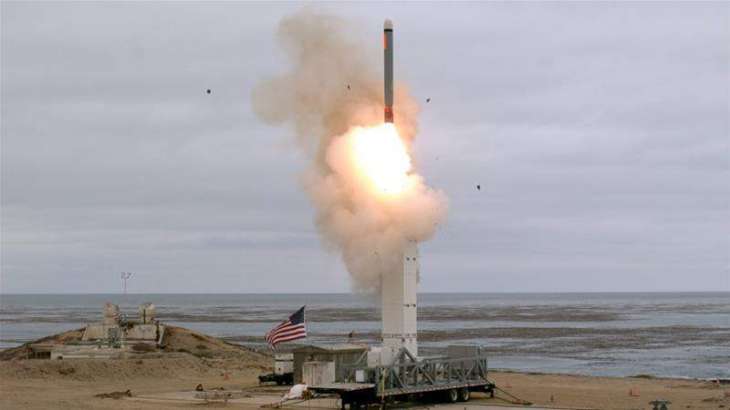The United States no longer makes a secret of the fact that it is developing a hypersonic missile with a ballistic warhead with a range prohibited by the recently scrapped Intermediate-Range Nuclear Forces (INF) Treaty, to which Russia was the second signatory
MOSCOW (Pakistan Point News / Sputnik - 26th August, 2019) The United States no longer makes a secret of the fact that it is developing a hypersonic missile with a ballistic warhead with a range prohibited by the recently scrapped Intermediate-Range Nuclear Forces (INF) Treaty, to which Russia was the second signatory.According to US Acting Secretary of the Army Ryan McCarthy, the United States is "looking at where can we [the United States] first find opportunities" following the country's official withdrawal from the INF Treaty on August 2.
However, Washington is still lagging behind Russia in terms of development of hypersonic weapons and is spending a lot of money to close the gap.
Russia is the only country in the world to have officially unveiled it possessed hypersonic weapons. This past February, Russian President Vladimir Putin announced that the Avangard hypersonic missile system had entered serial production and that Zircon hypersonic cruise missiles had successfully been tested. The military is currently putting the Kinzhal air-launched hypersonic ballistic missile through test operations.
In order to catch up, the United States is conducting tests across several projects of its defense program, Prompt Global Strike, which envisions the capability of attacking an enemy object with conventional weapons airstrikes anywhere in the world within an hour of the corresponding order. Hypersonic weapons are a key element of Prompt Global Strike.
One of such project is the X-51A Waverider hypersonic missile, which was tested for the first time on May 26, 2010. These tests were considered only partially successful due communication failures and the fact that the missile appeared to be unstable, the projectile received a self-destruct message in the third minute of its flight. During this time, however, the Waverider managed to reach a speed of Mach 5, or five times the speed of sound.
The tests that took place in the spring of 2011 were also deemed unsuccessful after the booster failed to separate from the missile. During the third test launch in August 2012, the missile lost control and fell into the Pacific Ocean in the 17th second of flight.
On May 1, 2013, the Waverider performed its first successful test. The missile, fired from a B-52 bomber, reached a speed of Mach 5.1 and a height of almost 60,000 feet. The projectile covered more than 426 kilometers (364 miles) in just over six minutes.
The Waverider was expected to be put into service in 2017, but the deadline was extended for a number of reasons. According to the latest reports, the missile will enter operational service no earlier than 2020.
Beyond the Waiverider, the Pentagon has also conducted tests of a hypersonic warhead under the Advanced Hypersonic Weapon (AHW) program. According to the plan, the AHW should strike targets with conventional warheads that are 6,000 kilometers away from the launch point 30-35 minutes after being launched. The circular error is not to exceed 10 meters. The developers have completed two test launches, one of which was successful.
AHW program achievements will be used to create a Tactical BoostGlide aircraft, for which a contract was signed in March with US defense contractor Raytheon. According to the company's website, the booster will be able to travel at a speed of over 6,000 kilometers per hour.
The Defense Advanced Research Projects Agency (DARPA) and the US Air Force attempted another project devoted to developing an unmanned hypersonic missile glider from 2003-2011. Tests of the Falcon HTV-2 guided combat unit took place on April 20, 2010. The vehicle reached a speed of Mach 20 in the upper atmosphere, but contact with it was subsequently lost. The project was shut down after the second HTV-2 was launched unsuccessfully on August 11, 2011.
Another program launched by DARPA and the US Air Force is the Hypersonic Air-breathing Weapon Concept, which aims to develop an air-launched hypersonic cruise missile. Additionally, DARPA is working on the Operational Fires project, where it is developing a ground-launched hypersonic system.
Finally, US defense contractor Lockheed Martin is working on Hypersonic Conventional Strike Weapon and the more innovative Air-Launched Rapid Response Weapon, both competitors of Russia's Kinzhal. In April and August of 2018, the company signed contracts with the Pentagon for $928 million and $480 million, respectively.
In May 2019, breaking Defense digital magazine cited a statement by Lt. Gen. Neil Thurgood, head of the US Army Rapid Capabilities and Critical Technologies Office, on a ground-based complex under the name Hypersonic Weapons System.
The two-container launcher, towed by a large eight-wheeled vehicle and armed with the highly maneuverable hypersonic warhead of the Common Hypersonic Glide Body is now being designed for the needs of the US Army, Navy and Air Force by experts from Sandia National Laboratory, a contractor for the US Department of Energy's National Nuclear Security Administration. According to Thurgood, it will be able to fly at speeds of up to Mach 8. The tests are scheduled to take place in 2021.




